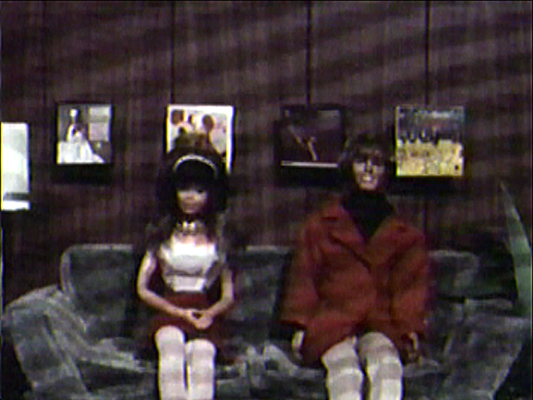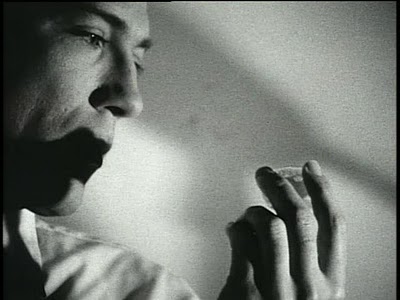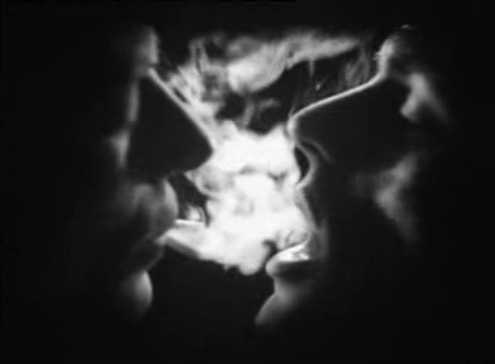From the Chicago Reader (July 12, 1991). — J.R.
POISON
*** (A must-see)
Directed and written by Todd Haynes
With Edith Meeks, Larry Maxwell, Susan Norman, Scott Renderer, James Lyons, John R. Lombardi, Tony Pemberton, and Andrew Harpending.
“The whole world is dying of panicky fright,” reads the title that opens Todd Haynes’s startling and original Poison. It’s a correct and judicious observation, one that helps to “explain” a fascinating and provocative movie, particularly if one sees it alluding directly to the specter of AIDS.
But if one starts to enumerate the symptoms produced by panicky fright in our culture, I’m afraid that the usual set of liberal grievances — greed, intolerance, xenophobia, repression, classism, sexism, racism, homophobia, war fever, and flag waving — doesn’t quite exhaust them. Some of the most cherished and least controversial emblems of postmodernist discourse — irony, stylistic pastiche, and a foreshortened sense of history and politics, all of which are usually employed together — may be symptoms of panicky fright as well. While the list of liberal grievances points to a fear of the world (especially the social world) as it is, postmodernist discourse suggests a fear of discourse (especially art) as it used to be and as it might be once again — a fear of unambiguous self-expression that implies another way of refusing to confront the present directly.
I don’t mean to suggest by this that Poison isn’t bold and adventurous. It’s a packed and largely purposeful 85-minute-film that intercuts three separate stories in a way that produces a good many potent, novel, and interesting effects. And as social protest, it’s stronger than many other examples around. But the postmodernist traits it employs — all of which can be found in different forms in La femme Nikita, Terminator 2: Judgment Day, Truth or Dare, and the films of Ari Kaurismaki, among other recent (and more mainstream) examples — can be read both as symptoms of the times we’re living in and as critical commentaries about them.
Mistrusting a direct and unmediated personal discourse, these movies all try to “subvert” the popular modes of expression they simultaneously mock and honor, mangle and depend on — hoping that truth will somehow emerge from a juxtaposition of lies, a tissue of ironies. What emerges may be tantalizing as spectacle and potent as partial send-up or beguiling brain puzzle. But more often than not, it seems guarded — indeed, downright fearful — as discourse. Contradictory attitudes are worked into the material, the specter of camp perpetually hovers as a potential qualifier and disclaimer, and the possibilities of unambiguous self-expression — without the security blanket of quotation or pastiche — are implicitly backed away from as unhip. We all get something from these covert transactions, but we also lose a lot — particularly a faith in language itself.
It could be argued of course that Todd Haynes is well aware of this problem and that Poison is conceived in part as a scheme for both addressing and subverting the reflexes of a fearful postmodern audience. Up to a point, I think that this is Haynes’s strategy, but whether it functions entirely according to his plan is another matter. Yet if Haynes bites off more than he can chew, this is ultimately a disadvantage that he forces his audience to share; given the breadth of his ambitions, and the ideological stone wall that he’s battering against, he can be credited with stirring up a healthy amount of confusion. If he fails on some levels, he fails much more interestingly than most current movies succeed.
Haynes’s Superstar: The Karen Carpenter Story (1987), a 43-minute underground sleeper, is unfortunately legally unviewable now because of an injunction concerning music rights slapped on the film by Richard Carpenter, Karen’s brother. An analytical docudrama about the career of the superwholesome pop singer and her death as a result of her anorexia nervosa, the film uses Barbie-like dolls (not actual Barbie dolls, as is often reported) in dollhouselike settings to portray the Carpenter family. While the use of these dolls and settings is implicitly satirical throughout, the film proceeds less as overt black comedy than as a studied, deadpan pastiche of the pop biopic, complete with montage sequences, dialogue scenes, talking-head interviews, and so on. It shows considerable mastery of its chosen genre (the rules of continuity cutting are strictly adhered to, for instance).

Given the film’s consistency of tone and its technical rigor, it would be misleading to label it simply as sarcastic camp but not wrong to point out that the response it invites is similar. Insofar as the Carpenters were represented (and represented themselves) as dolls in the media, the film’s method functions as an ironic distancing device throughout; the facts may be grim, but the audience’s capacity to greet them with superior, knowing laughter is never very far away. The emotional claims of the music, for instance, are never allowed to implicate the audience the way they did in Elaine May’s The Heartbreak Kid, which used the Carpenter hit “Close to You.” Insofar as the homogenized mainstream image of Karen Carpenter served to alienate — albeit mainly unconsciously — large sections of her audience, including Karen Carpenter herself, the film exacts a kind of revenge on this general principle by literalizing its implications and making the Carpenters themselves wholly “other.” The results are rather brilliant, but also rather heartless and shortsighted: the psychopathology of apparent “normality” that this film ruthlessly investigates doesn’t include the cheerful and jeering cynicism that is provoked in the viewer. (Richard Carpenter, who has reportedly never seen the film, declined Haynes’s offer to show the film only in clinics and schools and donate all the proceeds to the Karen Carpenter memorial fund for anorexia research.)
Significantly, the opening shot of Poison — a hand-held subjective moving camera shot of what’s behind a closed door — virtually inverts the opening shot of Superstar. In both cases one or more authority figures stands outside a door (Carpenter’s mother outside Karen’s bedroom in Superstar, police and neighbors outside the flat of the lover of a leprous sex criminal in Poison), and are appalled by what they see once they step through. The crucial difference is that Poison gives us a shot in motion from the viewpoint of the captive inside — hiding from the police when they break through the door, then escaping through a second-story window; in Superstar Karen Carpenter is already dead.
The most exciting moments in Poison are those that create a momentary confusion about which of Haynes’s three stories one happens to be watching — moments of vertigo during which two or more of the three stories seem to fuse (or, perhaps more to the point, “bleed” together). The opening shot retrospectively constitutes the first of these moments. By the time we discover which story a shot belongs to, we’ve forged enough imaginative links between the three stories — their overall meanings as well as their details — to experience directly some of the reasons Haynes chose to juxtapose them.
The three stories, each of which is set in a different period and couched in a different style, can be summarized as follows (spectators who prefer to encounter Poison without benefit of advance synopses are invited to skip the next three paragraphs):
“Horror”: Shot in black and white, this story is mainly cast in the style of a cheap 50s SF horror melodrama with moralistic overtones, complete with 50s clothes and decor. Dr. Tom Graves (Larry Maxwell), a scientist, “isolates the sex drive” in a serum that he accidentally swallows around the time he’s greeted by Dr. Nancy Olsen (Susan Norman), a fan of his work who wants to assist him and who quickly falls in love with him. Becoming leprous from the serum and reclusive whenever he isn’t infecting others, Graves is soon labeled a public menace (“LEPER SEX KILLER ON THE LOOSE” screams a tabloid headline). But Olsen continues to pledge her undying love for him, even after she becomes infected. When the police, gawking neighbors, TV reporters, and merchants selling leprous masks surround Olsen’s building, Graves denounces them all from the fire escape: “You think I’m scum. You think I’m dirt, don’t you?” he cries, adding that they’re all exactly the same, “but you’ll never know it because you don’t know what pride is. . . . Pride is the only thing that allows you to cope with misery.” He leaps to his death; momentarily regaining consciousness as doctors and nurses peer down at him in a hospital emergency ward, he hears the flapping of wings and says, “I hear an angel farting on the ceiling.”

“Hero”: Shot in overlit pastel colors, this story is partially done in the style of a talking-head TV expose. In a Long Island suburb on June 3, 1985, seven-year-old Richie Beacon (seen only briefly and elliptically) shoots his father dead and literally flies out the window. Interviews with his mother, Felicia (Edith Meeks), and various adults and schoolmates gradually reveal that he was an outcast who seemed to provoke an inordinate amount of bullying violence from other boys. We also eventually learn that Richie and Felicia were both subjected to frequent violence from Richie’s father. About a week before the murder, Richie, unexpectedly brought home from school with a sprained wrist, spied his mother having sex with the gardener in her bedroom. We also learn that the murder was directly provoked by the father beating Felicia because of her infidelity, and that Felicia views the incident in religious terms. (“I know that I was wrong — but my child was watching over me. My child was an angel of justice, and I sinned against the Lord.”)
“Homo”: This story — set mainly in 1944, with flashbacks to 1929 — is shot in subdued, metallic colors (mainly blue and gray) in a prison and in sudsy, muted colors during bucolic flashbacks to stone ruins near a reform school. It’s narrated by John Broom (Scott Renderer), a homosexual thief who is sent to prison, where he reencounters and develops a strong sexual attraction to Jack Bolton (James Lyons), whom he knew in reform school 15 years earlier. After a series of guarded dialogues with Bolton that reveal Broom’s jealousy of Bolton’s popularity among the other prisoners and of Bolton’s former partner in crime, Broom attempts to fondle Bolton while he sleeps and, on another occasion, rapes him. Then Broom recalls an incident at the reform school when he spied Bolton being spat upon repeatedly by five other boys, a form of humiliation Bolton seemed to delight in. Later Broom describes how Bolton was killed by a guard while attempting to escape from prison.
The pastiche styles of “Horror” and “Hero” are mainly parodic — send-ups of 50s SF horror films and contemporary TV news stories that encourage the viewer to take a position of jeering superiority to these modes of discourse (just as Superstar encourages one to feel superior to both the music and psychopathology of Karen Carpenter and the form of the pop-music biopic). But the styles of “Homo” seem more sincere than ironic (I’m told that the style of the reform-school segments owes something to the 70s soft-core gay feature Pink Narcissus, which I haven’t seen). Indeed, it might be said that the overall type of pastiche employed in “Homo” is more literary than filmic — specifically the world, characters, and behavior conjured up in Jean Genet’s Our Lady of the Flowers, Miracle of the Rose, and The Thief’s Journal, three books mentioned in Poison‘s credits as having inspired this film. (I’ve been told that even the names of characters are anglicized versions of names found in Genet: “John Broom,” for instance, for “Jean Genet.”)
From one point of view, Haynes’s attitude toward these styles can be viewed as a calculated inversion of mainstream attitudes toward both the styles and implied content of the discourses he is appropriating. But in the case of “Homo” he seems handicapped by the example of Genet’s artistry — not only the artistry of Genet’s prose, but also the artistry of Genet’s own remarkable silent film Un chant d’amour (1950), both of which make Haynes’s efforts at paraphrase seem relatively pedestrian. And there are other problematic complications. Both “Horror” and “Hero” work only fitfully and superficially as stylistic parodies, each temporarily abandoning its elected style for the sake of subjective hand-held moving camera shots or making other stylistic departures (perhaps the most striking and effective of these departures, in “Hero,” creates a split-screen, rear-projection effect to depict Richie’s discovery of Felicia having sex with the gardener). Furthermore, the parodic tone of the dialogue isn’t always strictly adhered to; in “Horror” Graves’s climactic denunciation of the crowd seems delivered in a way we’re supposed to take “straight” — one of the few instances in the film when Haynes seems to be trying to escape his postmodernist ground rules and offer us a relatively unmediated discourse.
There are clear advantages to Haynes’s intercutting. By creating three illustrations of societal repression and scapegoating — sex as disease in “Horror,” confusions about childhood guilt and innocence in “Hero,” and the prison settings of “Homo,” which might be said to foster the inverted reproduction of certain attitudes in “straight” society outside — Haynes encourages us to see complex poetic and political interrelationships between the stories and their meanings that mutually inform one another (for instance, the means by which the ultimate defilement of Graves, Richie, and Bolton become associated with a form of angelic ascension). But the issue of masochism, which plays a substantial role in all three stories, can’t be easily sorted out from the issue of persecution, and Haynes’s method isn’t always conducive to distinguishing between the two. Surely part of what he’s dealing with is the means by which societal victims conspire in their own victimization — a central theme in Superstar — but another part has to do with intolerance pure and simple (e.g., the means by which contemporary responses to AIDS are worthy of the schlockiest 50s SF xenophobia, and the degree to which popular fantasies about child abuse turn children into illegible abstractions).
In the case of “Hero,” where the very notion of moral authority is undermined by the chintziness and naivete of the people being interviewed, we have no way of knowing to what extent Richie provoked his own persecution or to what extent his classmates are rationalizing their own cruelty toward him. In the case of “Horror,” the cliche-ridden discourse about Graves as a sex offender fosters more confusion than clarity about what his actual offenses are (as opposed to what people think they are). Admittedly, in both cases this confusion is part of Haynes’s subject, but the degree of ambiguity he insists on sustaining about these matters makes one wonder at times how much his movie qualifies as a symptom of the kind of confusion he’s trying to analyze.
The stupidity and intolerance of society play central roles in “Horror” and “Hero,” but in “Homo” they seem confined in concrete terms to the inability of a prison official to speak the word “homosexual” and his query to Broom about whether the term consists of one word or two. (More generally, Broom remarks offscreen, “In accepting prison life, embracing it, I could reject the world that rejected me.”) Does this mean we’re supposed to regard the cruelties of the prisoners and reform-school kids with more leniency than the cruelties of the little boys who beat up Richie or the little girl who spits on Richie? Surely the unusual amount of freedom that Haynes grants the spectator in synthesizing his diverse elements plays a substantial role in raising these unanswerable questions.
In any case, it’s not a freedom I’d like to wish away. When Poison won the top prize at the Sundance film festival last January, the New York Times characteristically heralded the news with the headline, “GAY FILM WINS TOP PRIZE AT SUNDANCE FESTIVAL” — a headline that, as David Ehrenstein pointed out in the Advocate, echoes the headline “LEPER SEX KILLER ON THE LOOSE” in “Horror.” In various ways and at separate junctures, Poison qualifies as an angry protest against, an exploitation and celebration of, an investigation into, and a consequence of the panicky fright that this whole world is dying of — a lot more, in short, than any of us is equipped to handle, Haynes included.
But I’d rather settle for the freedom of choice offered by Poison than for the narrower options offered by most recent Hollywood films — and suggested by that New York Times headline and by the Reverend Donald Wildmon, who attempted to discredit the National Endowment for the Arts for giving a $25,000 grant to Poison (one tenth of the film’s budget) without even bothering to see the movie. Come to think of it, I’m much more disturbed by the federal grants accorded to military marching bands — larger than all the other federal grants accorded annually to the arts in this country — which no one even dreams of protesting. If military marching bands and their ideological equivalents are what you crave, you certainly don’t have to go far to find them. Whatever its faults and confusions, and in spite of its desire and capacity to offend, Poison has absolutely nothing in common with military marching bands — another reason to highly recommend it.






